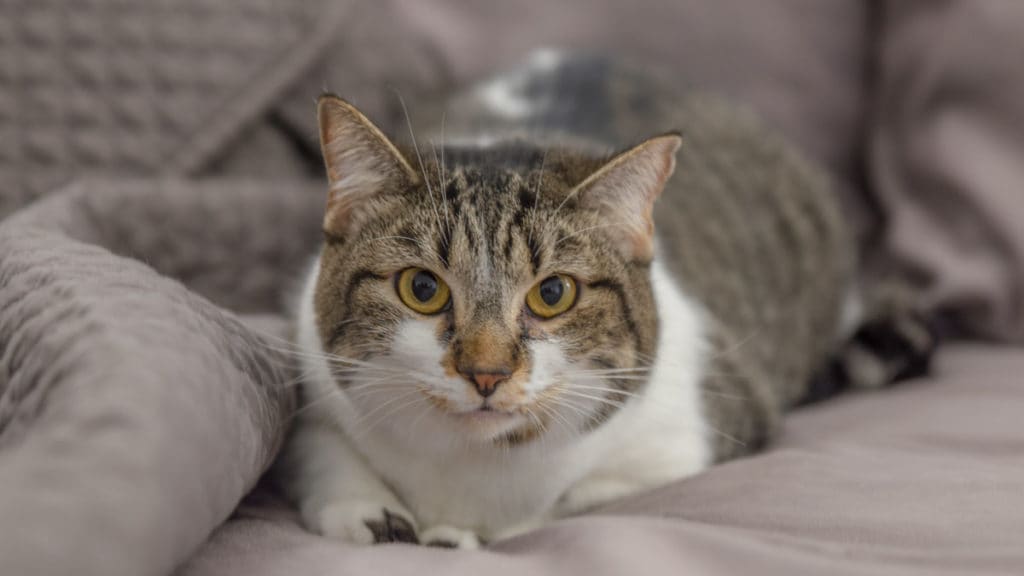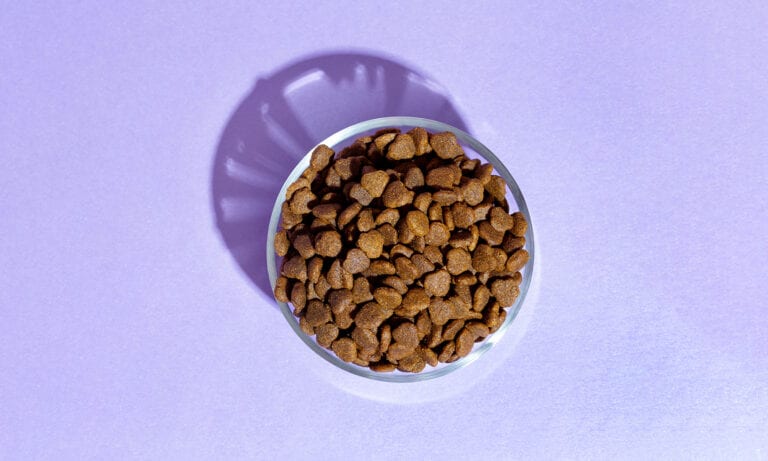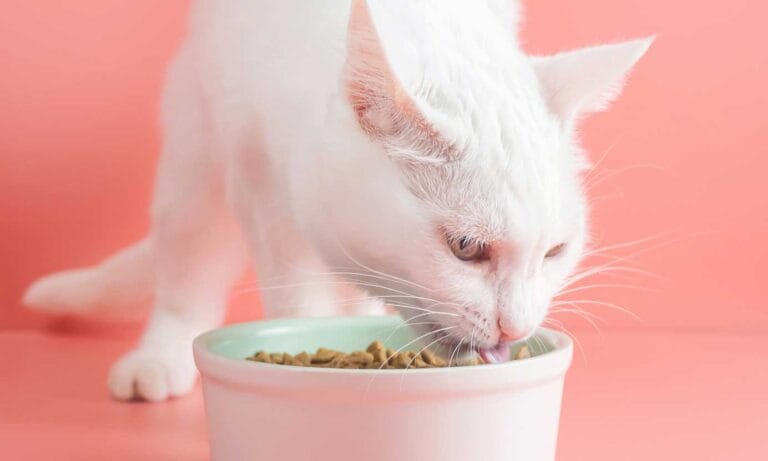It is well-known that cats need a diet that’s high in animal proteins, so why then are some kitties being prescribed low-protein cat food? We talked with Dr. Ann Hohenhaus, DVM, staff doctor at the Animal Medical Center in New York City, and Dr. Alison Birken, owner and DVM of Victoria Park Animal Hospital, to learn more about low-protein cat foods and why they would prescribe them.
Low-Protein Doesn’t Mean No Protein
Cats are obligate carnivores, which means the nutrition they need to stay healthy is derived from protein and fat. Dr. Hohenhaus explains, “All pet food is composed of protein, fat and carbohydrates—and if one goes up, the others go down so that a complete and balanced diet is created.” So it is important to note that a low-protein cat food will still contain a nutritionally necessary amount of protein. She elaborates by saying, “These prescription diets have reduced protein compared to regular diets, but protein still makes up a fairly reasonable portion of the diet.” While the protein is reduced, it is normally of a higher quality, so it is more easily digested and metabolized by your cat’s body.
This means that even if your cat is prescribed a low-protein diet, you can rest assured that they are still getting a healthy, balanced meal that will satisfy all of their nutritional needs.
Cat Food Plays an Important Role in Cat Health
Dr. Birken explains, “Nutrition and diet play important roles in the overall wellness and health of your pet, but are even more significant when your pet is ill.” So when choosing cat food, you need to take your cat’s entire health profile into account and adjust their food to fit their evolving needs. She adds, “Frequently, I prescribe specific prescription diets for my pet patients that will help treat, support and benefit them through diseases. These diets provide specific vitamins, supplements or ratios of ingredients to support the fight against specific diseases.”
Low-protein cat food is often one of the special food recommendations made by veterinarians. Dr. Birken says, “One diet I frequently recommend and prescribe for my pets is a low-protein diet. These diets are formulated with a lower percentage of protein in comparison to the average wellness pet foods. Most of these diets will contain around 12% protein. The most common diseases that I prescribe low-protein diets for are kidney and liver disease.”
How It Can Help With Kidney Disease in Cats
Veterinarians prescribe low-protein cat foods primarily for liver and kidney disease in cats. These organs deal directly with the metabolizing and excreting of protein. So a cat that’s suffering from these type of issues benefits from a decrease in protein because it means less work for those organs.
Kidney Disease in Cats. Dr. Birken says, “Chronic kidney disease is a very common diagnosis in elderly cats. Approximately 3 out of 10 geriatric cats will be diagnosed with chronic kidney disease.” The reason why low-protein cat foods are commonly prescribed for chronic kidney disease is the close correlation between the job of the cat’s kidneys and the protein. The main jobs that a cat’s kidneys perform include:
- Breaking down and eliminating protein waste
- Balancing body water, salts and acids
- Producing urine as a waste product
Since, as Dr. Birken explains, “One of the main functions of the kidneys is to break down and excrete proteins,” a cat with compromised kidneys will need to adjust their protein intake. Low-protein cat foods help limit the amount of work the kidneys have to do, so that they can operate more efficiently and keep your cat feeling healthy. Dr. Hohenhaus elaborates, “When protein is digested, the waste products are excreted through the kidneys, so reduced-protein diets help to decrease the kidneys’ workload.”
Not only is the protein content smaller, but the protein used to formulate these diets is highly digestible, which lessens the amount of waste produced during digestion. Reduced-protein diets also have lower levels of phosphorus, which aids kidney function. “Keeping phosphorus in the normal range also makes a cat feel better,” points out Dr. Hohenhaus.
Reduced-protein diets also include antioxidants to help protect kidneys from further damage, and essential fatty acids for their anti-inflammatory properties. Frequently, potassium and B vitamins are added to compensate for the kidneys’ decreased ability to retain adequate amounts of these compounds in the body, says Dr. Hohenhaus. “These pet foods are formulated to be extra tasty, since cats with kidney disease often have poor appetites.” Reduced-protein diets have high energy density (many calories per mouthful), so cats with a small appetite can consume a smaller amount of food, while still meeting their daily needs.
For cats with kidney disease, ask your veterinarian about Purina Pro Plan Veterinary Diets NF Kidney Function Formula. This cat food has low levels of protein and phosphorous to cater to your kitty’s health needs. If your cat prefers wet food, there’s also Purina Plo Plan Veterinary Diets NF Kidney Function Wet Food.
Liver Disease in Cats. Dr. Birken explains, “The liver performs many important functions for the body, such as removal of by-products from the digestion of food, absorption of food, and the production of proteins necessary for normal blood consistency and clotting. The liver also converts ammonia, a toxic by-product of protein metabolism, into urea, which is excreted in the urine. When pets have liver disease or failure, the liver is compromised and cannot properly perform these functions.”
When dealing with liver disease in cats, an appropriate diet is essential for managing liver health. A low-protein cat food will be recommended if a veterinarian determines that your cat’s liver is no longer able to efficiently and successfully convert ammonia, a toxic by-product of protein metabolism, into urea so that it can be excreted in the urine. By providing your cat with a lower amount of higher-quality protein, it can prevent the buildup of ammonia in their bloodstream, which can lead to more severe health issues like a condition called hepatic encephalopathy.
Maintaining a Healthy Appetite With Low-Protein Cat Foods
Once your cat has been transitioned over to a low-protein diet, it is important that you consistently monitor their food intake. The low-protein cat foods may tend to be higher in calories, but most cats that are suffering from kidney or liver disease suffer from a decreased appetite, so it is important that you make sure they are eating enough to stay healthy. If you notice your cat not eating their low-protein food, it is crucial that you talk with your veterinarian and work with them to figure out a meal plan that works for your cat.

Jennifer Kelly Geddes is a New York City writer/editor and the mom of two teenage girls. She’s also the devoted owner of a rescue pup named Django, a temperamental Shepherd mix. Geddes has worked for Food & Wine, Parenting, Seventeen and Airbnb magazines and creates content for dozens of sites, including Care, Fisher-Price, the National Sleep Foundation and Realtor.
Share:











